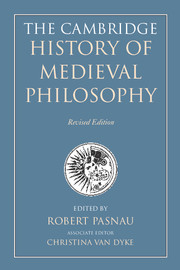Book contents
- Frontmatter
- Contents of Volume 1
- Preface
- List of contributors
- Frontmatter
- Contents of Volume 2
- Introduction
- I Fundamentals
- II Logic and language
- III Natural philosophy
- IV Soul and knowledge
- V Will and desire
- VI Ethics
- VII Political philosophy
- VIII Metaphysics
- 44 The subject of the aristotelian science of metaphysics
- 45 Essence and existence
- 46 Form and matter
- 47 Realism
- 48 Nominalism in the later middle ages∗
- 49 Accidents and modes
- IX Theology
- Appendices
- Bibliography of primary sources
- Bibliography of secondary sources
- Index nominum
- Index rerum
- References
45 - Essence and existence
from VIII - Metaphysics
Published online by Cambridge University Press: 05 August 2014
- Frontmatter
- Contents of Volume 1
- Preface
- List of contributors
- Frontmatter
- Contents of Volume 2
- Introduction
- I Fundamentals
- II Logic and language
- III Natural philosophy
- IV Soul and knowledge
- V Will and desire
- VI Ethics
- VII Political philosophy
- VIII Metaphysics
- 44 The subject of the aristotelian science of metaphysics
- 45 Essence and existence
- 46 Form and matter
- 47 Realism
- 48 Nominalism in the later middle ages∗
- 49 Accidents and modes
- IX Theology
- Appendices
- Bibliography of primary sources
- Bibliography of secondary sources
- Index nominum
- Index rerum
- References
Summary
SOURCES FOR THE SCHOLASTIC DEBATE
At least two issues contributed to the extensive discussion of essence and existence by Latin thinkers in the thirteenth and early fourteenth centuries. First, there was a need to explain the metaphysical structure of immaterial entities other than God (angels, within the Christian tradition) in a way that would distinguish them from the absolute simplicity of God, especially for those who rejected the possibility of matter–form composition both for such entities and for human souls (see Chapters 21 and 46). Second, there was a need to account metaphysically for the distinction between God, the uncaused cause who necessarily exists, and all other beings, which depend on something else for their existence.
This famous scholastic dispute over the relationship between essence and existence has its roots in earlier Latin and Arabic discussions. Among Latin sources, Boethius was especially influential. He begins his De hebdomadibus by listing a series of axioms, some of which compare and contrast that-which-is (id quod est) and being (esse). Consider, for instance, Axiom II: “Being and that-which-is are diverse”; Axiom VII: “Every simple entity has its being and that-which-is as one”; and Axiom VIII: “In every composite entity its being and that-which-is are diverse.” With some exceptions, modern interpreters of Boethius do not see in this contrast a real distinction between essence and existence (esse) as two distinct intrinsic principles of being. Rather, according to many of these interpreters, Boethius compares and distinguishes between a concrete entity (that-which-is) and a form in which it shares (esse). In simple beings they are identical, whereas in composite beings they are diverse.
- Type
- Chapter
- Information
- The Cambridge History of Medieval Philosophy , pp. 622 - 634Publisher: Cambridge University PressPrint publication year: 2014
References
- 1
- Cited by



